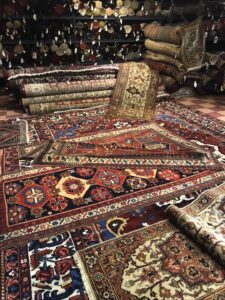Types of Oriental Rugs
You’re probably familiar with the concept of Oriental rugs. They’re beautiful carpets that are as treasured as works of art, but do you know how to define them? What makes a rug an Oriental rug?
More than just your average living room rugs, Oriental rugs are created by specialized rug makers in the Middle East who hand-knot them with careful attention to detail. All Oriental rugs are woven on a loom by hand, and the process that goes into them is steeped in tradition and cultural heritage. You can tell if your Oriental carpet is authentic by looking at the back: the back of a hand-knotted Oriental rug will have the same image as the front, but mirrored, while a fake rug will have a harder back with no design.

Many people use the terms “Oriental rugs” and “Persian rugs” interchangeably, but this is inaccurate. Oriental rugs can come from all over the Middle East, including Pakistan, Persia, Afghanistan, India, Tibet, Nepal, and Turkey. So, while all Persian rugs are Oriental rugs, all Oriental rugs are not Persian rugs. Oriental rugs vary widely in pattern, color, and style, based on the regions and cultures in which they’re made. Let’s look at some of the different types of Oriental rugs and how you can tell them apart.
- Bokhara Oriental rugs originated in central Asia. Once made by nomadic tribes known as Tekke, they’ve existed for 500 years and are very eye-catching. They feature geometric shapes and unique patterns that are divided into two types. Royal Tekke patterns are elongated and featuring bold red colors, while Princess Tekke patterns are religious in nature and feature a shape known as a mihrab, which points to Mecca. Bokhara rugs feel luxuriant because of their high pile, but they’re not the best option for high traffic areas.
- Ikat rugs have neutral tones and originated in 17th century Italy. The process of making these rugs involves weaving the yarns before dyeing them, and it creates blurred lines of cloth. Ikat rugs have a calming look and can go with just about any interior décor style.
- Kilim Dhurrie rugs are pileless, with a flat surface. They’ve been created since 2000 B.C. and the name comes from a Persian word that means “spreading roughly.” They come in a variety of patterns, typically bold, sharp, and geometric. The weave makes them shed-resistant and comfortable to walk on, so they’re good for just about any room.
- Chobi rugs were originally made in Turkey. They have a pale palette, typically a beige background with brown and wood colored patterns. They’re now made primarily in Pakistan and they’re popular throughout the world. Ziegler rugs, which are made in England, are a type of Chobi rug.
- Soumak rugs originated in the Shirvin region of the Caucasus, in the 17th century. They have been a tradition in Iran and Kurds were the first to use them as area rugs but today, they’re primarily found in India and Pakistan. Soumak rugs are finely woven and hardy, created with flat weave like Kilim rugs. They don’t have a plush feel, but resemble a tapestry, but with a smooth texture on one side and ragged on the other.
- Moroccan Berber rugs have long been created in the southern parts of Morocco. The knowledge of weaving these rugs is passed down from one generation of women in the tribe to the next. These rugs are thickly woven, as they were once used as blankets and covers for animals of the Berber tribes. They have simple, linear designs and are warm and snug.
- Persian rugs are from the country formerly called Persia, now known as Iran. They’re an extremely famous type of rug, old and traditional, with beautiful, unique, precise craftsmanship. Unlike other Oriental rugs, which use geometric patterns, Persian rugs feature organic shapes like flowers, fruit, crosses, and lotuses. Traditional colors for Persian rugs are red, blue, and gold.
If you’re looking for high-quality Oriental rugs or meticulous Oriental rug cleaning near Memphis, TN, trust Taghavi’s Oriental Rugs. Since 1977, our family-owned and operated rug store has been providing exceptional quality rugs and reliable services to customers all over the world. Based in Memphis, our store features a large inventory of hand-crafted Oriental rugs, some made by master weaver Ali Taghavi, others by respected rug weavers in other parts of the world. We also provide onsite Oriental rug cleaning and repair services, with experienced professionals doing all the work by hand. Contact us for a no-obligation estimate, check out our inventory of more than 5,000 Oriental rugs for sale or talk to us about custom-made rugs.
